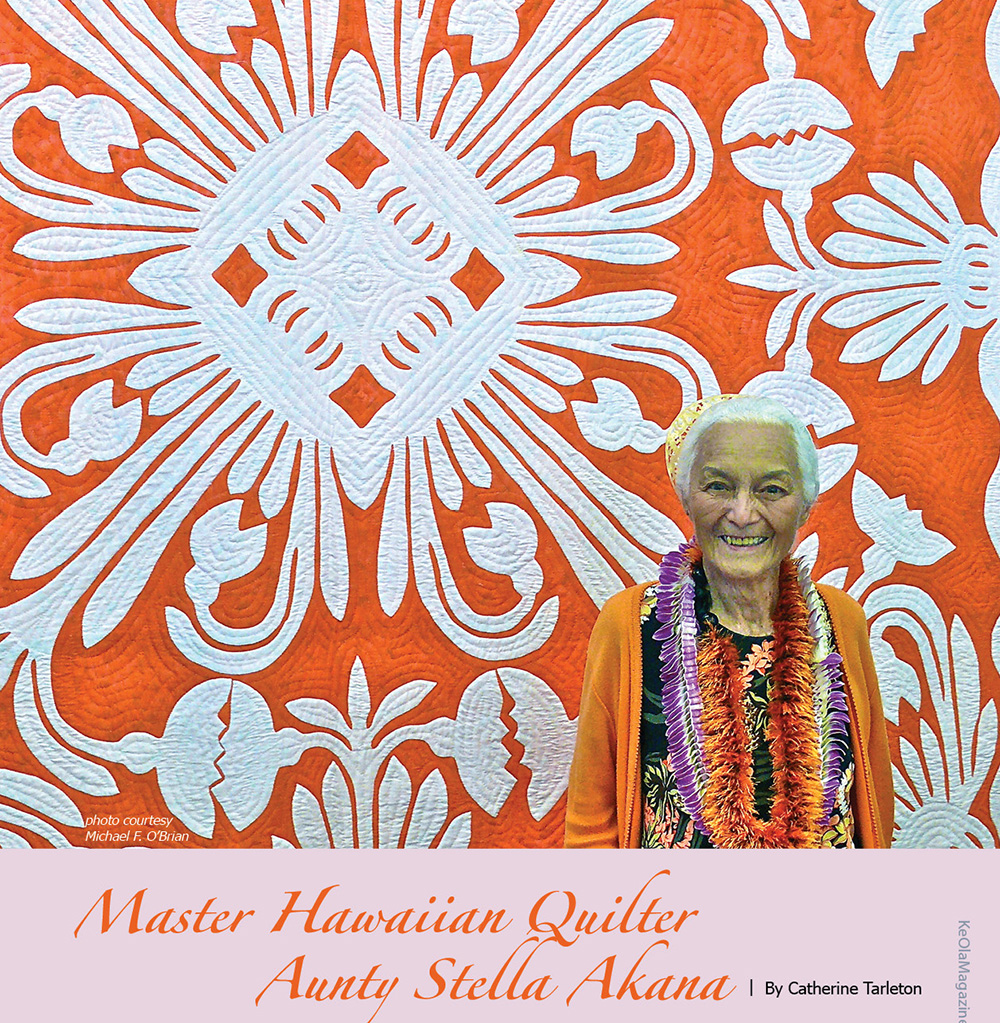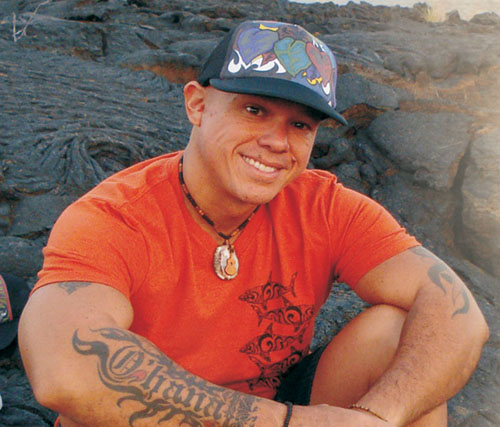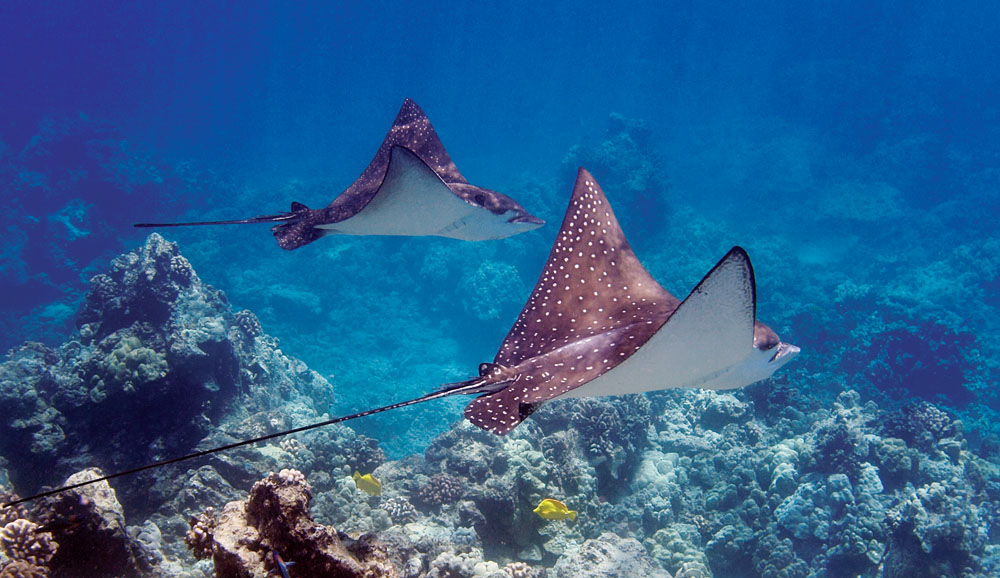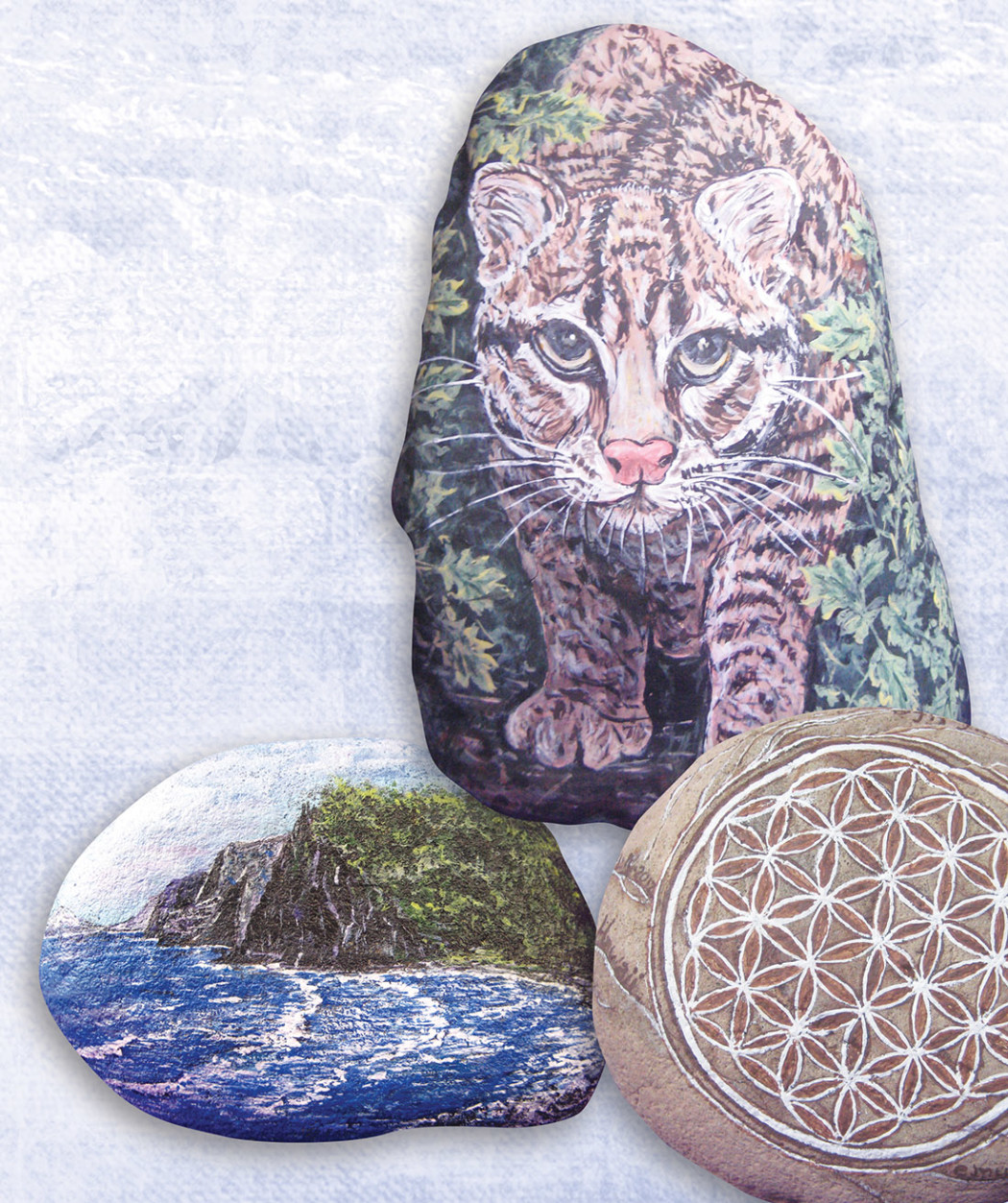
Master Hawaiian Quilter Aunty Stella Akana

By Catherine Tarleton
Lined with echoing ripples that mark her journey’s years, her face tells the story of smiles and joys and meticulous craftwork. With needle and thread, Aunty Stella Akana (“Granny” to her extended ‘ohana) creates master works in fabric and time, stitch by tiny, perfect stitch.
At age 96, Stella has completed 25 quilts, all by hand. Most recent is a vivid floral, red-on-white pattern of her mother’s done in the old-fashioned “wāwae moa” (chicken feet) style—distinctive for its little crosshatched embroidery on appliqué fastened to the quilt backing. The quilt, now resting on her parents’ koa four-poster bed, has a story of its own.
“All my motherʻs quilts were stolen from our home,” says Stella. “We rented our house for about two years, and I guess someone saw my cousin go and air out the kapa…[and then] broke into the one room we had locked.”
Years later, so the story goes, a Japanese housekeeper on the mainland saw the quilt, made a copy of the pattern, and sent it to Ka Hui Kapa Apana O Waimea Quilting Club—who recognized it as one of the family’s designs and brought it to Granny.
“I did it in colors I figure Mother would have used,” she says. “The pattern is a flower that Sam Parker’s wife had in her garden, and she shared her flowers, she brought this particular lily, the red pānānā, from the mainland and grew at Mana [the Parker home]. It looked like a red slipper orchid.”
In the traditional style, the kaleidoscopic floral pattern is cut from one piece of cloth, folded, and folded again—like an old-fashioned paper snowflake. Stella said this is the first one she’d ever cut herself, usually relying on a quilting partner to take care of that part for her.
“I don’t know why I was afraid to cut,” says Stella. “I called my friend and said ‘I did it!’”
Today Stella wears a maile lei, sitting by the window with a book, Moloka‘i by Alan Brennert. She loves to read. On the walls beside and behind her are paintings—her own—landscapes from the island, flowers from her yard.
“Artists won’t show you everything,” says Stella with a smile. “They only show you so much, and then after that, it’s up to you.” She fondles the maile, lifts it to her nose. The lei is a gift from Daniel “Kaniela” Akaka and his father, Retired US Senator Daniel Akaka.
“Kaniela and his father always bring a maile lei,” says Stella, pointing to the sliding glass. “Last night, I looked up and they were standing outside the door. His father didn’t look much taller than me. I thanked him for all the years he gave as a Senator.”
Stella Servia Ha‘ilaua‘ala Spencer’s father passed away two months before she was born. He had wanted a daughter very much, and requested if the baby was a girl she could be named Stella after his second wife. Stella’s middle name, Servia, was the name of the ship that brought her grandparents to Hawai‘i. Her Hawaiian name, Ha‘ilaua‘ala, means “the fragrance of a crushed leaf.” And that is why Senator Akaka always brings her the maile lei.
Her mother died when she was three years old, and Stella was raised by her Aunt Hannah and Uncle Robbie Hind. Theirs was a ranching life, and Stella remembers long days in the saddle with the paniolo.
“We used to drive cattle over the lava from Pu‘uwa‘awa‘a to Kīholo and Kawaihae,” says Stella. “The [ship] Humu‘ula came and picked up the cattle. It took more than one week. We had to hunt the stray cattle, pick the ones to sell, then get up at 4am and ride to Kīholo, rest one night, and take them over in the morning to be shipped. Then half the boys would go pick ‘opihi and half work.”
She graduated from Kamehameha School, class of 1936, in Honolulu, where she met future husband Albert “Sonny” Akana.
“I had to carry a big stick to scare off the girls—he was so handsome,” she boasts.
Returning to the family home in Waimea, Stella worked many years in the human resources department of Mauna Kea Beach Hotel, where she admired “Mr. Rockefeller’s Collection” of Hawaiian quilts made by Meali‘i Kalama and the ladies of Kawaiahao Church in Honolulu. Stella, however did not learn to quilt until years later.
“I had a friend who worked for Parks and Recreation, and at the time [1972] there were lots of programs for boys to keep them happy. So I asked her ‘what do they have for women, especially for us women?’ She said, ‘What do you think we ought to ask for?’ So I told her ‘Quilting is a dying art. We should have quilting classes.’ She told me, ‘Go get 14 people together for the class, and we’ll get the resource person.’”
That was the beginning of Hui Apana O Waimea Quilting Club, the state of Hawai‘i’s first.
At that time in the 1970s, the Hawaiian Renaissance was gaining rapid momentum—a time of revitalized interest in and energy devoted to the Hawaiian culture. The renaissance created a surge of demand for education, Hawaiian language and hula to be taught in schools, support of the first voyages of Hōkūle‘a, and more.
Looking back only 40 years, it is hard to imagine that so much of the culture was being forgotten, that the cry for cultural education had to come from students.
“Now we have 40 members,” says Stella. “I am so pleased to see the interest to retain things Hawaiians did. I think it’s going to last.”
For Stella, as she has learned quilting, quilting has taught her as well.
“You have to be patient, otherwise it’s going to show,” says Stella, who does all of her quilting by hand, never with a machine. She has made quilts for all of her children and grandchildren. “How long it takes—all depends on the pattern and time you spend on it. A half-hour per day can get it done in one year.”
The art of Hawaiian quilting grew from the existing work of kapa-making. Women, generally, would make cloth from the bark of wauke (paper mulberry) plant in a painstaking process of pounding and drying its fibers into soft mats. Working in teams, they beat the fibers into fabric with specifically crafted handheld beaters made of dense wood. When finished, the mats would be decorated with patterns and natural plant dyes applied with carved bamboo stamps.
Missionary wives taught wahine (women) to sew in the 19th Century.
Isabella Bird in her 1870 book, Six Months in the Sandwich Islands, describes a quilt with a “floral center with surrounding arabesque design.” One story suggests patterns were inspired by the leafy shadows on cloth, as the women sewed in the shade. Creating the pattern is a method similar to scherenschnitte, the cut-paper “snowflake” technique, brought to the islands by German-American missionaries.
Other than Hawaiian flag quilts, often made to show unity after the overthrow of the monarchy, most Hawaiian quilt patterns feature one solid color, a repeating design of plants or flowers, appliquéd onto a white or solid color background.
Each quilt will be given a name by its maker, and each quilt will have a “kaona,” or secret underlying story. Quilts are made to honor the birth of a child, to remember a loved one, or to commemorate a special time or historic event.
“What the Hawaiians came up with was amazing,” says Stella. “Kapas are so funny,” she says. “Hawaiians made kapas and put so much religion to it. The kapas show lots of inner feelings, patterns, colors. But they never used black. Black meant death—many of the patterns are people’s dreams.”
Stella leans over her sewing table, checking progress on what she says is her final quilt, ‘Lokelani,’ a beautiful pattern of roses in pink and green. On her thumb, she wears the 14K gold thimble that was her mother’s, and she hums a little tune while her fingers do their quiet work, stitch by stitch. ❖
Aunty Stella will be showing three quilts in the Hawaiian Quilt Show, in conjunction with the 22nd Annual Waimea Cherry Blossom Heritage Festival, Saturday, February 7, 2015 from 9am–3pm at Mana Christian Ohana’s Kahilu Town Hall (across from Kahilu Theatre).
Numerous quilting clubs from across the island will be represented, including Stella’s Ka Hui Kapa Apana O Waimea.
For more information on quilting clubs: 808.961.8706
Contact writer and photographer Catherine Tarleton


